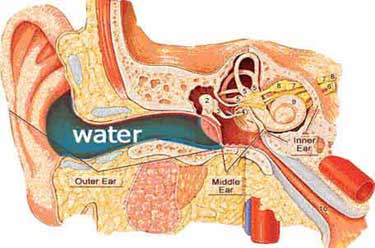By Madison Scott
Quiet Times Staff Writer
Known as “Swimmer’s Ear,” otomycosis is a fungal infection of the external ear, accounting for about 10% of all external ear infections. Otomycosis is often accompanied by tinnitus.1 As its nicknames suggest, this condition often occurs due to excessive moisture in the ears.

In a recent clinical study, the predominant complaints associated with otomycosis were itching and ear discharge, followed by ear pain, a feeling of fullness, hearing loss, and tinnitus, with 20% of the patients suffering from all of the above.1 However, in a retrospective review, only 5 out of 132 patients experienced tinnitus due to otomycosis.2 It appears that swelling leads to a buildup of discharge and earwax, which in turn causes temporary conductive hearing loss. This might explain the presence of tinnitus as a symptom.
Other predisposing factors include a lack of healthy earwax, or trauma to the ear, both of which can be caused by improper cleaning. Some sources suggest that the presence of earwax actually acts as a foundation for the growth of fungi, though this usually applies in cases of excessive build up. Widespread use of antibiotic eardrops, broad-spectrum antibiotics, and steroids appear to have a hand in the increased prevalence in recent years1, and those who work outdoors or live in tropical climates are more susceptible. Immunocompromised individuals, such as those with diabetes, HIV, or other preexisting conditions, are also more susceptible.
 Aspergillus and Candida are the most common types of fungus to cause otomycosis, though Aspergillus Niger (right) is generally accepted as the primary cause, accounting for about 70% of all infections.3 It is a common food contaminant, a black mold which often grows on a variety of fruits and vegetables, and is also prevalent in soil, especially in the presence of decomposing vegetable matter. The fungal spores can become airborne, at which point they are carried by water vapors and may be lodged in the ear, multiplying under the proper conditions.
Aspergillus and Candida are the most common types of fungus to cause otomycosis, though Aspergillus Niger (right) is generally accepted as the primary cause, accounting for about 70% of all infections.3 It is a common food contaminant, a black mold which often grows on a variety of fruits and vegetables, and is also prevalent in soil, especially in the presence of decomposing vegetable matter. The fungal spores can become airborne, at which point they are carried by water vapors and may be lodged in the ear, multiplying under the proper conditions.
Because the symptoms are relatively nondescript, physicians must differentiate from similar looking conditions, especially bacterial infection, in order to properly diagnose and treat otomycosis. While microscopic inspection generally indicates fungal infection because of the distinctive structures formed, clinical diagnosis can be misleading and should therefore be accompanied by a culture to prevent misdiagnosis. In a review from an otology practice in Houston, Texas, 45% of patients were treated with ototopical eardrops, and 24% were taking oral antimicrobials before they were properly diagnosed.2
The first step in treatment is to thoroughly clean and dry the affected ear. Standard treatment following cleaning is a course of antifungal drops given several times a day for 1-3 weeks. Ketoconazole ointment and Clotrimazole are usually successful in treating infection and preventing recurrences.1,2 When cleaning the ear, removing any unhealthy tissue and suction evacuation are preferable to flushing with fluids. This is due to the nature of the condition, and to avoid possible complications from sending fungal spores deeper into the ear.
While otomycosis is a condition, which can typically be treated with relative ease, there is also the possibility of invasive ear infection, at which point the fungal infection spreads to bone and cartilage in the surrounding areas. This is a severe and potentially life threatening disease. Another complication, though it is far less serious, is the possibility of a perforation in the eardrum. This occurs in an average of about 14% of patients, and is usually attributed to clotting in the small veins of the tympanic membrane which causes tissue death due to a lack of blood supply.2 This is also a known cause of tinnitus. For elaboration on conductive hearing loss, and the complications a tear in the tympanic membrane might cause, please read our article Hearing Loss: An Overview.
It is important to avoid putting anything in your ear canal, not only to keep from doing damage to the eardrum and compacting wax, but also to keep the healthy balance created by these natural secretions in place. Earwax even has antifungal properties. Proper ear cleaning protocol can be viewed in the article Save Your Hearing Now. Ensuring cleanliness and thoroughly drying one’s ears after showering and swimming help to prevent excessive moisture. Although most individuals will experience immediate relief from tinnitus symptoms following treatment of this condition, some may continue to experience ringing in the ears. For these individuals, taking Arches Tinnitus Formulas may prove helpful.
References:
1 – Satish HS, Viswanatha B, Manjuladevi M: A Clinical Study of Otomycosis. IOSR-JDMS 2013;5.2:57-62.
2- Ho T, Vrabec JT, Yoo D, Coker NJ. Otomycosis: Clinical features and treatment implications. Otolaryngology-Head and Neck Surgery 2006;135:787-91.
3 – Chander J. “Aspergillus otomycosis.” Aspergillus Website. Available from http://www.aspergillus.org.uk/secure/treatment/otomyc.php. Accessed 14 May 2014.
